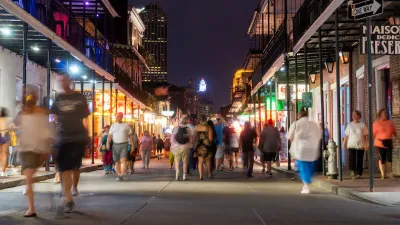Mark Guarino investigates the controversial construction of an expansive new development in the historic Lower Mid-City neighborhood of New Orleans.
Officials hope that BioDistrict New Orleans, a 1,500 acre medical and science corridor, will help to diversify the city's economy away from tourism, writes Guarino. A new veterans hospital was in the works before Katrina hit, but after the storm damaged the existing facility, plans were was accelerated and expanded. Additionally, the site will now include a 424-bed medical teaching facility as well as a new medical center and teaching hospital for Lousiana State.
However, 265 historic homes in the area, which is recognized by the National Register of Historic Places, stand in the way of the project, writes Guarino. Some have already been demolished, though at least 80 are being relocated by a non-profit group. With further demolitions on the way, the project is drawing fire from preservationists, writes Guarino:
"Critics say the project is a slap in the face of residents who spent three years after Katrina using federal Road Home funds to fix up their homes...The planned district is described by Sandra Stokes, executive vice chair of the Foundation for Historical Louisiana in Baton Rouge, as 'suburban sprawl in the most culturally significant urban environment in the US.'
'You're not revitalizing your downtown,' she says. 'You're evacuating your downtown and calling it economic development.'"
FULL STORY: New Orleans makeover: economic boost or loss of a historical legacy?

Alabama: Trump Terminates Settlements for Black Communities Harmed By Raw Sewage
Trump deemed the landmark civil rights agreement “illegal DEI and environmental justice policy.”

Planetizen Federal Action Tracker
A weekly monitor of how Trump’s orders and actions are impacting planners and planning in America.

The 120 Year Old Tiny Home Villages That Sheltered San Francisco’s Earthquake Refugees
More than a century ago, San Francisco mobilized to house thousands of residents displaced by the 1906 earthquake. Could their strategy offer a model for the present?

In Both Crashes and Crime, Public Transportation is Far Safer than Driving
Contrary to popular assumptions, public transportation has far lower crash and crime rates than automobile travel. For safer communities, improve and encourage transit travel.

Report: Zoning Reforms Should Complement Nashville’s Ambitious Transit Plan
Without reform, restrictive zoning codes will limit the impact of the city’s planned transit expansion and could exclude some of the residents who depend on transit the most.

Judge Orders Release of Frozen IRA, IIJA Funding
The decision is a victory for environmental groups who charged that freezing funds for critical infrastructure and disaster response programs caused “real and irreparable harm” to communities.
Urban Design for Planners 1: Software Tools
This six-course series explores essential urban design concepts using open source software and equips planners with the tools they need to participate fully in the urban design process.
Planning for Universal Design
Learn the tools for implementing Universal Design in planning regulations.
Clanton & Associates, Inc.
Jessamine County Fiscal Court
Institute for Housing and Urban Development Studies (IHS)
City of Grandview
Harvard GSD Executive Education
Toledo-Lucas County Plan Commissions
Salt Lake City
NYU Wagner Graduate School of Public Service





























